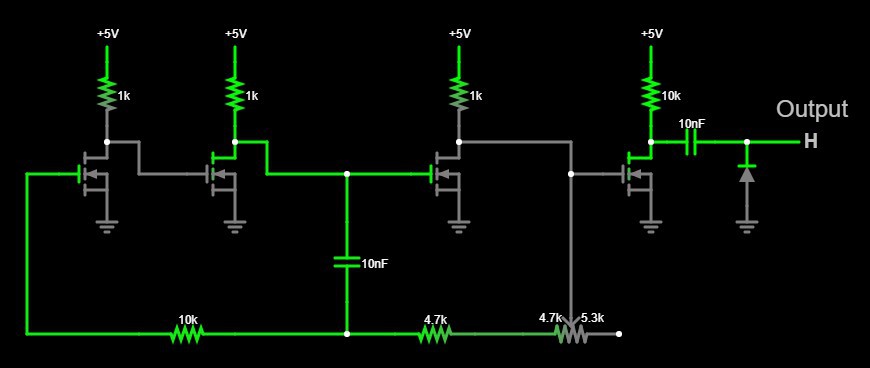
I wanted the board to generate it's own clock. I felt like the board would be a more complete package if included and didn't seem to be much of an issue to add. I came across Fairchild's Application Note 118 quickly in my search. The application note details a Ring Oscillator that is slowed by an RC circuit on the feedback line. It looked like exactly like what I needed, low parts count and can fit the NMOS logic theme.
To allow calibration I've added a multi-turn potentiometer on the right side of the feedback line so that adjustment to the output frequency can be made.
I breadboarded it up and it seemed to work just fine looking at the signal on the oscilloscope. I just had to add an inverter to the end to help square up the output waveform. At the time I wasn't sure what frequency I would end up using. I was planning for 9800Hz but wasn't sure if everything would work at that speed. To test the rest of the circuit before settling on a clock I used either a button to single step or my signal generator. This ended up being a bit of a problem for me as I thought that the clock would work perfectly when dropped in. I designed the rest of the layout while only leaving myself just enough room to add what I had already came up with for the clock.
I had everything working correctly while using the external clock from a signal generator. I then rebuilt the clock circuit on a breadboard and fed the output into the rest of the project and it did not run at all. I hooked the project back up to the signal generator to help debug and determined that a DC offset on the low voltage state of the clock was causing some major issues. I found that if the low side of the clock was above about 160mV then the rest of the project would not change state correctly. The low voltage portion of the clock signal was fluctuating between 180mV to 250mV. I was able to squeeze in a coupling capacitor on the output which got the offset down to about 10-30mV. After this addition, things started working correctly.
The clock signal still has some pretty bad ringing on it that I think are causing some minor issues but for the most part it works.
 Eric Ljungquist
Eric Ljungquist
Discussions
Become a Hackaday.io Member
Create an account to leave a comment. Already have an account? Log In.